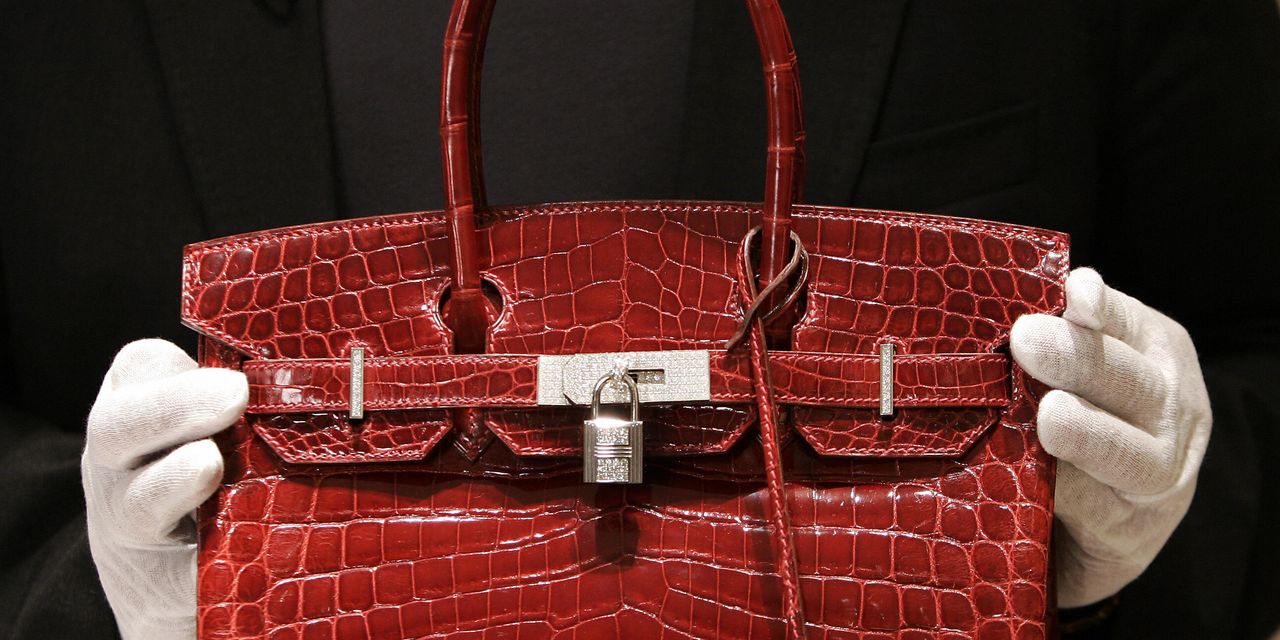In the world of pricey handbags, the Birkin stands apart. And while Jane Birkin may have died, her namesake bag’s hold on fashion is likely to remain, enduring as one of the ultimate status symbols.
Little wonder then that it’s a jewel in the crown of luxury powerhouse
Hermès.
A chance encounter on a flight between Jane Birkin and then Hermès International (ticker: RMS. France and HESAY) Chief Executive Jean-Louis Dumas led to the introduction of the carryall just shy of 40 years ago. Although Birkin briefly asked that her name be removed from the bag several years ago, plenty of other women (and men) have never wavered in their quest to own one.
While some Birkin bags can be had for a relative bargain under five-figures, the prices quickly move up, to around half a million dollars in one instance, making it the most expensive handbag in the world.
Their limited availability and coveted status can make them even pricier on the resale market. As auctioneer Sotheby’s notes, demand has driven up the price of Birkin bags over the past decades, meaning desirable previous models sell for many times their original retail price.
In fact, Birkin bags were a better investment than gold in the three and a half decades preceding the pandemic (when all manner of luxury goods saw increased prices). A study commissioned by online bag reseller Baghunter found that the value of the Birkin bag rose 500% in the 35 years ended 2016; just one year later, the average value had risen 16%.
Then the pandemic supercharged the cost of many goods, with luxury goods makers one of the first to raise prices. This created a virtuous cycle for Hermès and other high-end brands: Not only do eye-watering price tags keep margins high—Hermès’ gross margins averaged nearly 65% over the past five years and edged up to 66% in 2022—but they maintain exclusivity and cachet, as few consumers can spend so lavishly on a purse. That’s led the company to fiercely defend its valuable Birkin brand.
Of course, Hermès isn’t the only company that has found the uber-wealthy to be a desirable end market. Chanel hiked the price of its medium Classic Flap bag by three quarters in three years, making it pricier than the equivalent size Birkin for the first time.
The rarefied handbag wars may be something the average person never needs to understand, but it points to how purses’ function as status symbols prop up huge margins on what is, at heart, a bag that doesn’t function meaningfully better than one that costs one-thousandth the price.
Fellow luxury player
LVMH Moët Hennessy Louis Vuitton
(LVMH. France and LVMUY), which became Europe’s most valuable company this spring, saw sales soar in its most recent quarter, helped by wealthy Chinese buyers who have prioritized pricey goods as they emerge from pandemic restrictions.
And that harkens back to the subjective, often squishy definition of what is cool. Along with the Birkin, Hermès’ other blockbuster bag is the Kelly, named after Philadelphia-born movie star and fashion icon turned royal Grace Kelly. Chanel’s own brand carries the name of its pioneering (but controversial) French founder Coco Chanel. Luxury fashion houses, in general, are selling a story, and emotions, just as much as physical products.
Certainly high-price handbags’ fame have eclipsed that of their namesakes in many circles and entered the broader culture. But the idea of effortless chic, of a successful life of jet-setting and art that imbibed the lives of the women who inspired them, has enduring appeal that helps propel the myth behind the brands. In an increasingly crowded and time-starved world, a purse worth more than a car is a shorthand way to signal its owners’ worth and aspirations to fashion-savvy peers.
That enviable lifestyle is unlikely to lose its charm any time soon, meaning neither will Birkin bags, which in all probability will become even costlier. As with so many luxury goods, the price is the point.
Write to Teresa Rivas at [email protected]
Read the full article here







